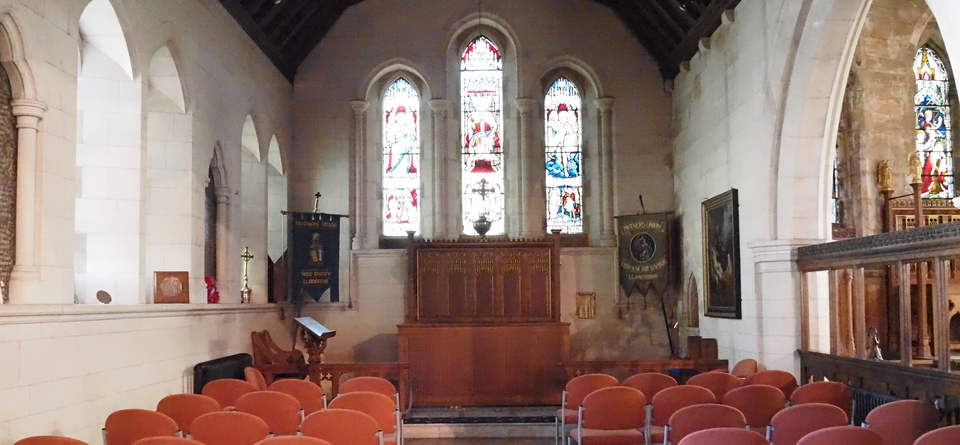
Adeiladwyd y Capel Coffa
Adeiladwyd y Capel Coffa, i'r gogledd o'r gangell, yn 1924 i goffau dynion Llandudno a fu farw yn y Rhyfel Byd Cyntaf. Mae'r dynion wedi'u henwi ar dair llechen farmor ar hyd y wal ogleddol.
Yn hongian yn y Capel Coffa mae baneri amrywiol gatrodau Cymreig a chymdeithasau gwasanaeth, sydd wedi eu gosod yno.
Defnyddir y Capel Coffa ar gyfer gwasanaethau pan ddisgwylir llai o bobl, megis yr Ewcharist am 8.00 am ar y Sul.
Wrth fynedfa’r capel mae stand cannwyll addunedol, sydd ar gael ar adegau gwasanaethau i unrhyw un a hoffai gynnau cannwyll wrth weddi.
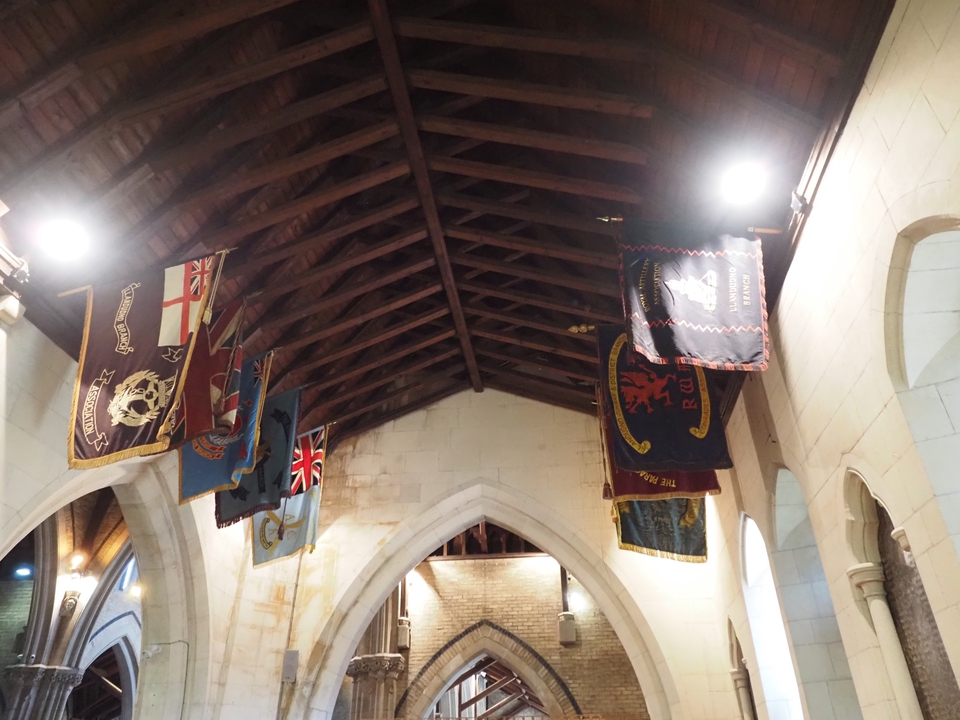
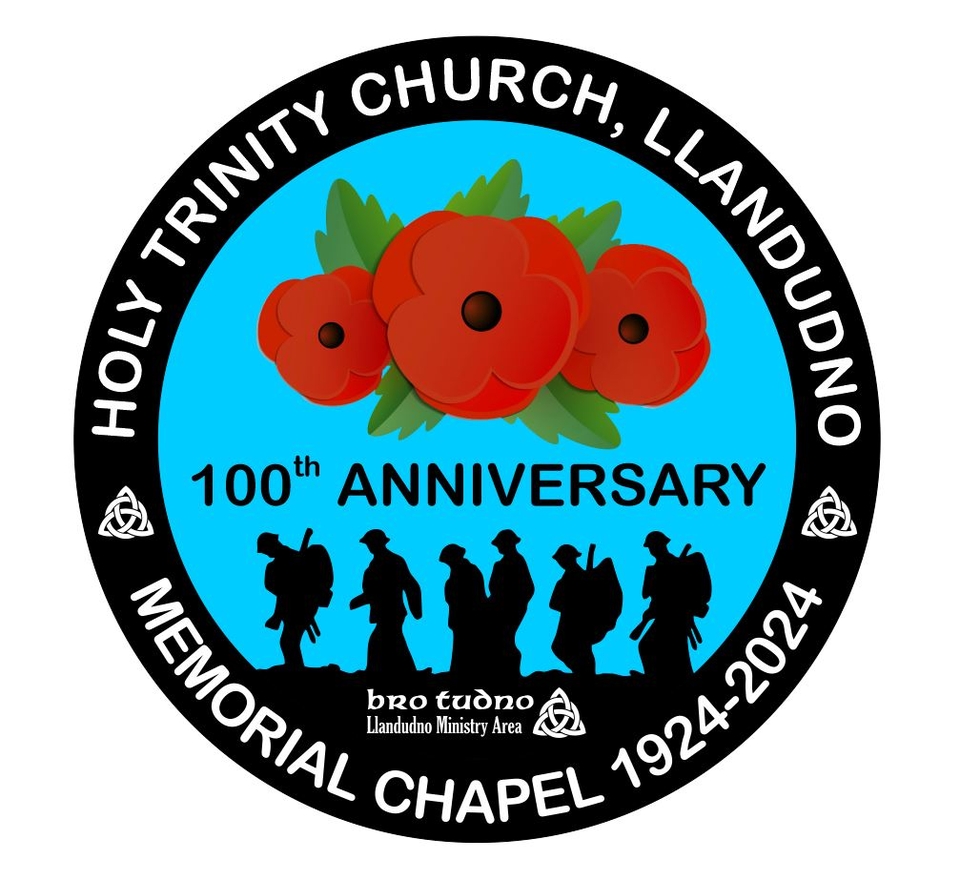
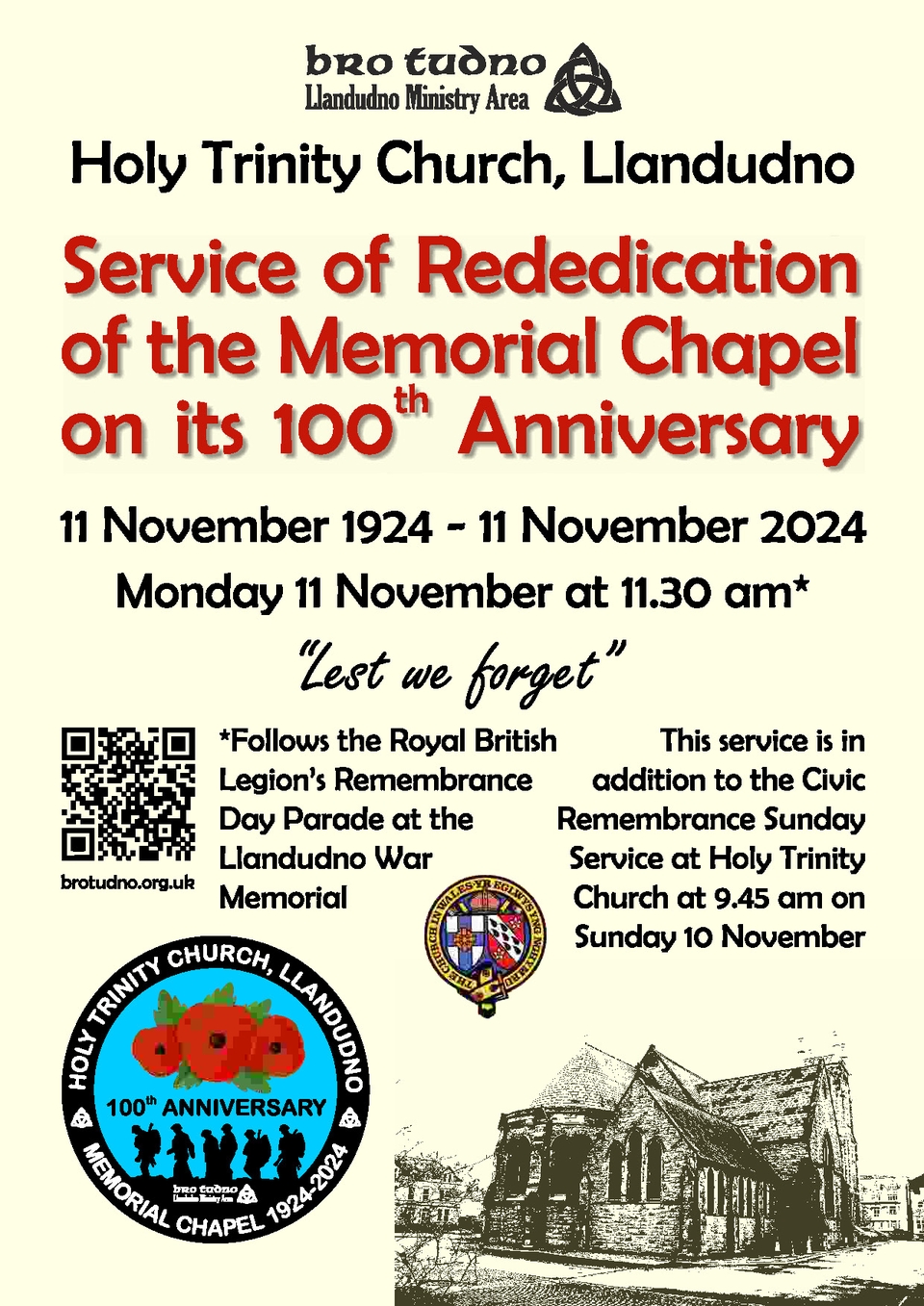
The following names were unearthed during research. Most could have been included on the marble tablets and some definitely should have been.
As printed in the Order of Service Booklet
Guy Everingham (Guy E D Jukes)
Second Lieutenant, No 16 Sqn, Royal Flying Corps
Killed in action, 8 April 1917, aged 22
Guy was born Guy Everingham Davenport Jukes at Barry, Glamorganshire in 1894 to William Webb Jukes and his wife Patricia Florence Everingham Jukes (née Davenport). He became a motor engineer at Newtown, Montgomeryshire (now Powys).
Guy enlisted into the First North Wales Pals at Rhyl in September 1914 which became the 13th (Service) Battalion at Llandudno the following month. He was a corporal when gazetted as a second lieutenant in February 1915. After serving in France, he was attached to the Royal Flying Corps in 1916.
Whilst on leave on 19 February 1917, Guy and Gwladus Annie Brown were married by the rector, Llewelyn R Hughes at Holy Trinity Church, Llandudno.
Guy Everingham was killed in action aged 22 on Easter Sunday, 8 April 1917 having been shot down by Baron von Richthofen.
Guy Everingham is remembered on a stone on his parents-in-law’s grave, in St. Tudno’s Churchyard. Since his wife was living in St. David’s Place, Llandudno at the time of his death, Guy’s name would normally have appeared on the Llandudno memorials. His wife’s remarriage in 1919 and moving away may explain this anomaly.
William Owen Hughes
Private, 1st Royal Welsh Fusiliers
Died of wounds, 22 October1917, aged 29
William, the son of Owen and Margaret Hughes was born in Bethesda in 1888. Shortly after, his family moved to Llanrhos. After leaving school, he was employed as a gardener. In 1908, he married Mary Ellen Edwards, and their daughter Dorothy was born the following year. In 1911, the family lived in Mostyn Street, Llandudno.
When William joined the Royal Welsh Fusiliers in August 1914, he named his wife as his next of kin with an address in Tudno Street, Llandudno. A son William George was born in March 1917.
William Owen Hughes disembarked in France in May 1917. He was wounded near Ypres in October 1917 and succumbed to those wounds that same month.
Mary Edwards married John Jones in 1919, taking up residence in Deganwy.
Because William Hughes’ widow had moved to Deganwy, his name appears on the Deganwy Village War Memorial in All Saint’s Church. Being resident in Llandudno when he volunteered in 1914, and nominally resident there when he died (he was still on the electoral roll), would normally be qualification enough to be commemorated the Llandudno memorials.
John Jones
Able Seaman, HMHS Llandovery Castle
Supposed drowned, 27 June 1918, aged 60
The name John Jones was probably the most common name in North Wales. Fortunately, research is considerably aided by the Llandudno Roll of Honour which included the rank and the service or corps of the fallen.
Amongst the Llandudno John Joneses listed by the CWGC is one John Jones who served in the Merchant Marine and whose name does not correspond with the Roll of Honour or, by inference, the other Llandudno Memorials.
John Jones was born in Llandudno in 1857 and became a seaman based in Liverpool.
In June 1918, he was an able seaman on the hospital ship HMHS Llandovery Castle when it was sunk by the German submarine U-86 when sailing from Nova Scotia to England. Many people lost their lives including 14 Canadian nursing sisters. The outrage was compounded because the captain of the U-boat ordered the machine gunning of the survivors. In the end, there were only 27, and they did not include John Jones who was now 60 years of age.
John Jones was survived by his mother. Though remembered on the Tower Hill Memorial in London, John Jones is not remembered on any memorial in his hometown.
John William Jones
Driver, Royal Army Service Corps
Died of wounds (gas), 31 December 1920, aged 60
Another John Jones not named in the Llandudno Roll of Honour is John William Jones of the RAOC.
John William Jones was born in 1859 though his early life is obscure. The first reliable record is that he married Mary Evans from Ilkeston in 1891. He also became a sailor and whilst he was at sea, his wife and children lived in Llandudno. He later became a foreman at the sewage works before returning to sea again.
Now back on land, John William Jones was too old to join up for active service. Nevertheless, still overage (the age limit was 50) he enlisted as a driver in the Army Service Corps in 1917.
He was gassed and medically discharged in March 1919. He died in the Ministry of Pensions’ Hospital (formerly the Military Hospital) at Bangor in December 1920 aged 60. He was buried at the Great Orme Cemetery, his grave being subsequently recognised as a War Grave.
Like his near namesake, John Jones, John William James is not remembered on any local memorials even though his widow lived on the West Shore.
Frank Mitchell
Private, PoW’s Own Civil Service Rifles (2/15th London)
Died after discharge, 15 July 1921, aged 40
Frank was born in Leamington Spa in 1880 and joined his father’s bath-chair business. His family relocated to Llandudno circa 1893.
By 1911 he had moved away from the town. It is recorded that he became a postman and was troubled with stomach problems.
In 1914, he enlisted into the Prince of Wales’ Own Civil Service Rifles. Whilst serving in France, he was deemed no longer fit to be a combatant and was transferred to the Labour Corps. He was discharged in May 1919 and lived in Llandudno with his parents.
Two months later, he was taken ill and he died in the Ministry of Pensions’ Hospital at Bangor on 15 July 1921. He was buried in the Great Orme Cemetery, his parents being interred in the same plot in 1925 and 1927. Frank has two grave markers: a CWGC headstone in slate in addition to his name on his parents’ headstone.
Frank Mitchell’s passing is similar to that of John William Jones (previous column). Both were discharged from the army in 1919 and subsequently died in the Ministry of Pensions’ Hospital in Bangor. Both are buried in CWGC-registered graves in the same cemetery and neither are named on local memorials.
Thomas Rocliffe Nicholls
Captain, TF Reserve, att 14th Hampshire Regiment
Killed in action, 26 September 1917, aged 41
Thomas Nicholls, the son of a banker was born in Guisborough in 1876. He became an apprentice at his father’s bank in Newcastle-under-Lyme and worked in various branches in England. He married Hilda Emma Culverhouse, and they had four sons. Having previously been commissioned in the Territorial Force, he rejoined as a lieutenant in the Territorial Force Reserve and was attached to the Hampshire Regiment in 1917. Thomas Nicholls was killed by shellfire in September 1917 and has no known grave.
Though there is no evidence of Thomas Nicholls ever having lived in Llandudno, his parents retired to Craig-y-don in 1909 and, in a biography printed after his death, his widowed mother still lived there. In 1921, Thomas’ widow Emma and their four sons were recorded as living in Deganwy.
Consequently, through his mother, living in Craig-y-don, and his widow, living in Deganwy, Thomas Nicholls could have appeared on both the Llandudno War Memorials (the town cenotaph and Holy Trinity) and the Deganwy Memorial in All Saints’ Church, Deganwy – but he does not. However, he is named on the Llanrhos (Remainder of the Parish) Memorial which is co-located with the Deganwy Memorial in All Saints’ Church.
Horace Illes Powell
Private, 4th Coldstream Guards
Killed in action, 30 March 1916, aged 25
Horace Illes Powell was born in Llandudno in 1890 and was educated at St. George’s National School. After leaving school, he worked as a draper in Nottingham and Hull. In 1914, Horace joined the Coldstream Guards, disembarking in France the following year. He was hit by a shell and killed instantly in March 1916.
Horace’s father had died in 1915, so it was Horace’s mother, still living in Llandudno, who received his effects and war gratuity. The census of 1921 records Horace’s family having moved to London. So it is possible that when the town of Llandudno was compiling its list of the fallen, Horace’s name was not included.
Horace Illes Powell is seemingly a unique name (Illes was his mother’s maiden name) and no local memorials in Llandudno or elsewhere commemorating him have been discovered.
Aldwyth Katrin Williams
Nurse, Voluntary Aid Detachment
Died of illness, 8 November 1918, aged 26
The daughter of the Rev Robert Williams and his wife Mary, Aldwyth was born in Dolgelly in 1892. Four years later, her father was appointed senior curate at Llandudno, in charge of Holy Trinity Church. In 1905, Robert Williams was appointed Rector at Llanbedr-y-cennin.
Aldwyth received a scholarship to the Welsh Girls’ School at Ashford in Middlesex and passed the Junior Cambridge examination with distinction in religious knowledge in 1907.
From 1914, Aldwyth was a Voluntary Aid Detachment nurse at the Red Cross Hospitals at Llandudno. VAD nurses were civilians, looking after sick or wounded soldiers. One of the hospitals was the “Balmoral” on Trinity Square which included a tented annex in the churchyard of Holy Trinity Church.
Aldwyth Katrin Williams was a victim of the Spanish flu epidemic and died in November 1918, three days before the Armistice. She was buried in her mother’s grave at St. Tudno’s Churchyard by the Rector of Llandudno the Rev. Llewelyn Robert Hughes.
As a VAD nurse assisting in a “home” hospital, her grave is not registered with the CWGC. However it is fitting that her memory be commemorated today with the acknowledgement that it was not only fighting men who were casualties of the conflict.
Morgan Scoltock Williams
Private, Army Service Corps (MT)
Died of illness, 17 May 1917, aged 23
Morgan Scoltock Williams was the son of William Williams, a butcher of Mostyn Street and later the licensee of the King’s Arms. In 1891, William and his second wife Emma lived at 6 Adelphi Street. Their son, Morgan Scoltock Williams was born in early 1894. William Williams died later that year and his wife died in 1903, leaving Morgan Williams an orphan.
Morgan Williams came under the guardianship of the Rev. W H Nixon, Vicar of Winster in 1905. Although found to be unfit for service, he joined the Army Service Corps (MT), seemingly to impress a young lady. On enlisting in April 1917, he gave his trade as an independent gentleman and his address as Winster Vicarage,
Morgan Williams was taken ill with measles and died of double pneumonia at Croydon on 17 May 1917 aged 23. He was buried in his family altar tomb at Llanrhos Churchyard.
Morgan Williams had made a “soldier’s will” written in his diary in which he left his estate to Miss May Prince though he neglected to rescind a former witnessed will in favour of the Rev. Nixon’s daughter. A court found in favour of May Prince, who received the small fortune of over £650,000 in today’s money.
A genuine son of Llandudno, Morgan Williams was unhappy in love and an unlikely warrior. Had he not moved away when orphaned, his war and life might have been very different.
And Finally ...
... this rededication of the Memorial Chapel would not be complete without giving thanks to God for the inspiration of the Rev. Canon Llewellyn Robert Hughes.
Canon Hughes was aged 69 when he died in 1925 having been ill for some time. Though not a casualty of war, he was one of millions of parents who had lost a son or daughter due to this conflict.
As well as marrying some to their sweethearts, he had been the padre of numerous fusiliers and other soldiers who had marched off to war, some to be maimed and others to be killed.
The loss of his youngest son must have affected him deeply yet it gave him the motivation to construct the chapel which we rededicate today. If it had not been for Llewellyn Hughes, then we would not be here today commemorating the 100th anniversary of his extraordinary vision.
Llewellyn Robert Hughes, the son of Robert and Mary Hughes, was born in Talyllyn Merionethshire in 1856. He married an Australian, Maria Elizabeth Sweetapple and they had three sons: Rhodri Henry (1891), Frederick Llewellyn (1894) and Hubert Darrell (1898).
The Memorial Chapel
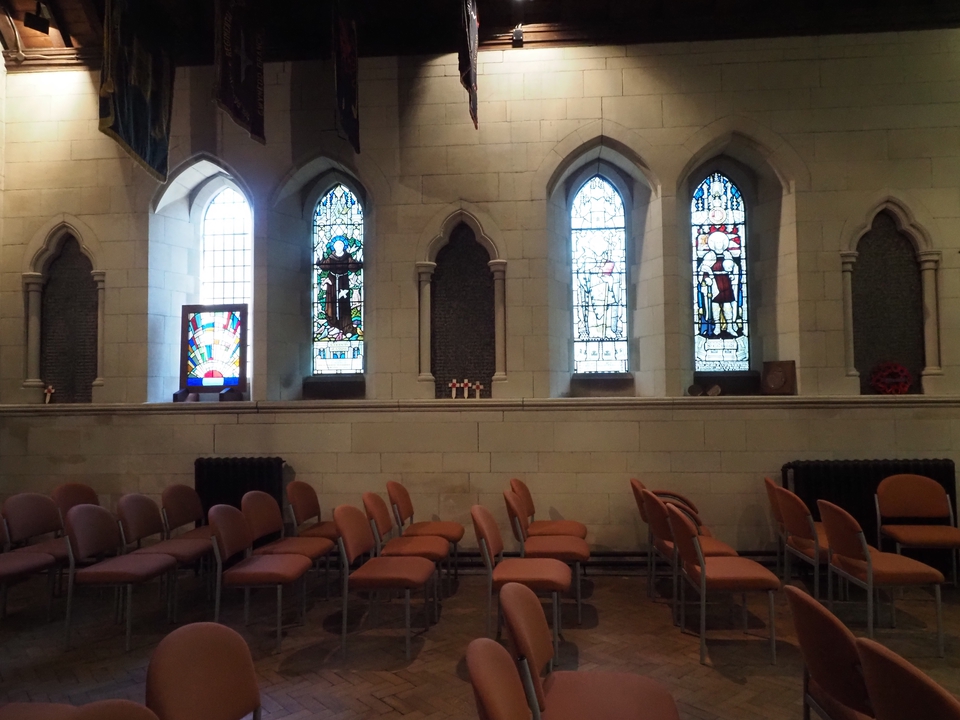
The Memorial Chapel, to the north of the chancel, was built in 1924 to commemorate the men of Llandudno who died in the First World War. The men are named on three marble tablets along the north wall.
Hanging in the Memorial Chapel are banners of various Welsh regiments and service associations, which have been laid up there.
The Memorial Chapel is used for services when fewer people are expected, such as the 8.00 am Eucharist on Sundays.
At the entrance to the chapel is a votive candle stand, which is available at service times for anyone who would like to light a candle when they say a prayer.
The names on the three marble tablets.
Those named in red are additional to those on the Llandudno War Memorial (1922).
See the Roll of Honour (1921) above to see ranks and units.

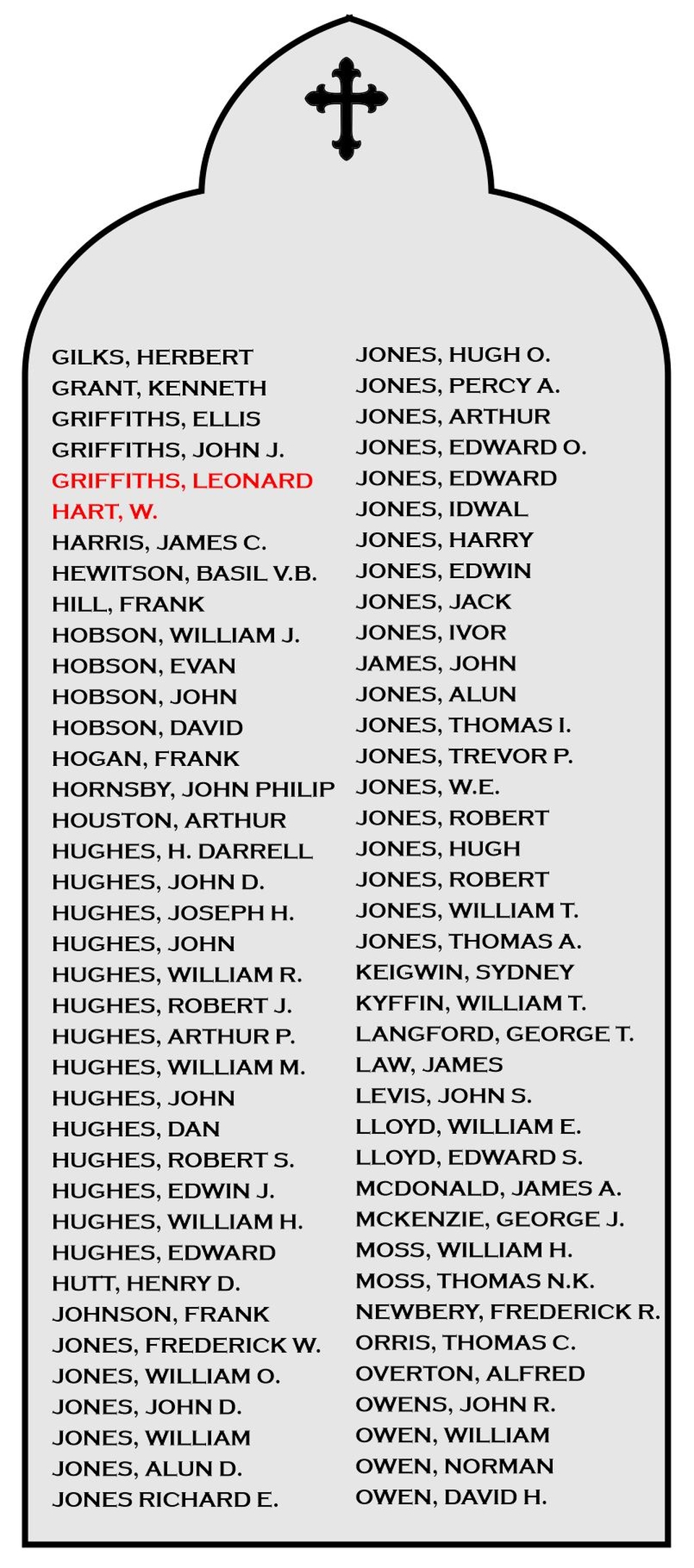
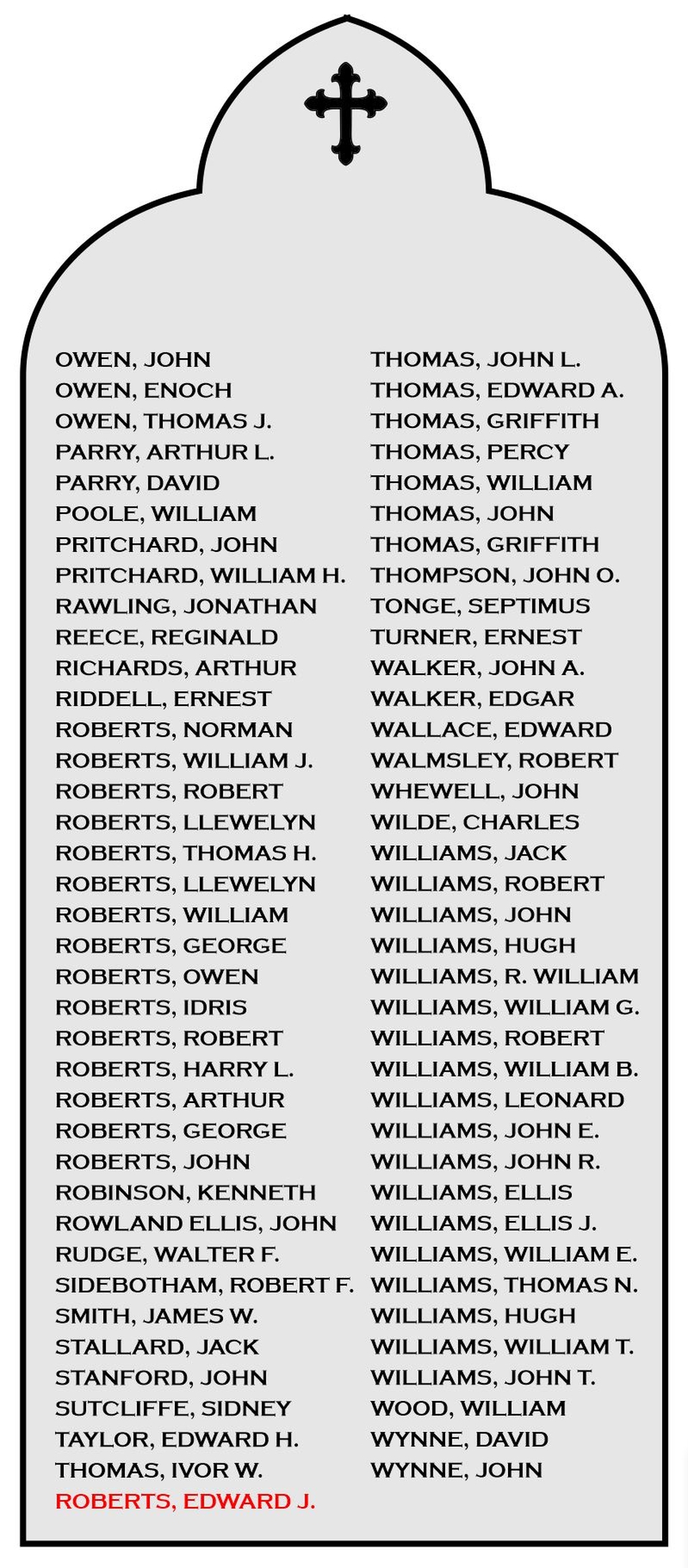
The name of Edward J Roberts was added after the chapel had been dedicated.

